

The Chemistry of Dienes and Polyenes. Volume 1
Edited by Zvi Rappoport
Copyright ∂ 1997 John Wiley & Sons, Ltd.
ISBN: 0-471-96512-X
CHAPTER 9
Synthesis of conjugated dienes and polyenes
GOVERDHAN MEHTA
Molecular Design and Synthesis Unit of JNCASR and School of Chemistry, University of Hyderabad, Hyderabad 500 046, India
Fax: 91-40-258367; e-mail: gmchem@uohyd.ernet.in
and |
|
H. SURYA PRAKASH RAO |
|
Department of Chemistry, Pondicherry University, Pondicherry 605 014, India |
|
Fax: 091-0413-65265; e-mail: bioinpu@iitm.ernet.in |
|
I. INTRODUCTION . . . . . . . . . . . . . . . . . . . . . . . . . . . . . . . . . . . . . |
361 |
II. ELIMINATION REACTIONS . . . . . . . . . . . . . . . . . . . . . . . . . . . . . |
364 |
A. General Aspects . . . . . . . . . . . . . . . . . . . . . . . . . . . . . . . . . . . . |
364 |
B. Dehydrohalogenations . . . . . . . . . . . . . . . . . . . . . . . . . . . . . . . . |
364 |
C. Dehalogenations . . . . . . . . . . . . . . . . . . . . . . . . . . . . . . . . . . . . |
364 |
D. Dehydration and Related Reactions . . . . . . . . . . . . . . . . . . . . . . . |
366 |
E. Reductive Deoxygenations . . . . . . . . . . . . . . . . . . . . . . . . . . . . . |
368 |
F. Decarboxylative Eliminations . . . . . . . . . . . . . . . . . . . . . . . . . . . |
372 |
G. Elimination of Sulphoxides and Selenoxides . . . . . . . . . . . . . . . . . |
374 |
H. Ramberg Backlund Reaction . . . . . . . . . . . . . . . . . . . . . . . . . . . |
374 |
I. Reductive Desulphonylations . . . . . . . . . . . . . . . . . . . . . . . . . . . |
375 |
J. Elimination of Silyl Groups . . . . . . . . . . . . . . . . . . . . . . . . . . . . |
376 |
K. Reductive Elimination of Nitroacetates . . . . . . . . . . . . . . . . . . . . . |
377 |
L. The Shapiro Reaction . . . . . . . . . . . . . . . . . . . . . . . . . . . . . . . . |
377 |
III. ADDITION ELIMINATION REACTIONS . . . . . . . . . . . . . . . . . . . . |
378 |
A. General Aspects . . . . . . . . . . . . . . . . . . . . . . . . . . . . . . . . . . . . |
378 |
B. Allyl and Vinyl Organometallics . . . . . . . . . . . . . . . . . . . . . . . . . |
378 |
C. Aldol Condensation-dehydration (Knoevenagel Reaction) . . . . . . . . . |
379 |
D. Wollenberg Method . . . . . . . . . . . . . . . . . . . . . . . . . . . . . . . . . . |
382 |
E. Sulphones (Julia and Related Reactions) . . . . . . . . . . . . . . . . . . . . |
388 |
IV. CONCERTED REACTIONS . . . . . . . . . . . . . . . . . . . . . . . . . . . . . . |
395 |
359

360 |
Goverdhan Mehta and H. Surya Prakash Rao |
|
|
A. General Aspects . . . . . . . . . . . . . . . . . . . . . . . . . . . . . . . . . . . . |
395 |
||
B. Extrusion of Neutral Species . . . . . . . . . . . . . . . . . . . . . . . . . . . . |
395 |
||
1. |
Sulphur dioxide . . . . . . . . . . . . . . . . . . . . . . . . . . . . . . . . . . |
395 |
|
2. |
Nitrogen |
. . . . . . . . . . . . . . . . . . . . . . . . . . . . . . . . . . . . . . . |
401 |
3. |
Carbon dioxide and carbon monoxide . . . . . . . . . . . . . . . . . . . . |
401 |
|
C. Ring Opening of Cyclobutenes . . . . . . . . . . . . . . . . . . . . . . . . . . |
402 |
||
D. Retro-Diels Alder Reactions . . . . . . . . . . . . . . . . . . . . . . . . . . . |
405 |
||
E. Orthoester Claisen Rearrangements . . . . . . . . . . . . . . . . . . . . . . . |
406 |
||
V. WITTIG AND RELATED REACTIONS . . . . . . . . . . . . . . . . . . . . . . |
407 |
||
A. The Wittig Reaction . . . . . . . . . . . . . . . . . . . . . . . . . . . . . . . . . |
407 |
||
B. Arsenic Ylides . . . . . . . . . . . . . . . . . . . . . . . . . . . . . . . . . . . . . |
412 |
||
C. The Horner |
Wadsworth Emmons (HWE) Reaction . . . . . . . . . . . . |
412 |
|
D. The Wittig Horner Reaction . . . . . . . . . . . . . . . . . . . . . . . . . . . . |
415 |
||
E. Iterative Wittig-type Reactions . . . . . . . . . . . . . . . . . . . . . . . . . . |
423 |
||
F. Peterson and Related Reactions . . . . . . . . . . . . . . . . . . . . . . . . . . |
424 |
||
G. Organotitanium Reagents . . . . . . . . . . . . . . . . . . . . . . . . . . . . . . |
426 |
||
VI. COUPLING REACTIONS . . . . . . . . . . . . . . . . . . . . . . . . . . . . . . . |
427 |
||
A. General Aspects . . . . . . . . . . . . . . . . . . . . . . . . . . . . . . . . . . . . |
427 |
||
B. Reductive Carbonyl Coupling Reactions . . . . . . . . . . . . . . . . . . . . |
428 |
||
1. |
The McMurry coupling reaction . . . . . . . . . . . . . . . . . . . . . . . |
428 |
|
2. |
Organozinc intermediates . . . . . . . . . . . . . . . . . . . . . . . . . . . . |
430 |
|
C. Homo-coupling Reactions . . . . . . . . . . . . . . . . . . . . . . . . . . . . . |
430 |
||
1. |
Organopalladium intermediates . . . . . . . . . . . . . . . . . . . . . . . . |
430 |
|
2. |
Organonickel intermediates . . . . . . . . . . . . . . . . . . . . . . . . . . . |
432 |
|
3. |
Organocopper intermediates . . . . . . . . . . . . . . . . . . . . . . . . . . |
432 |
|
D. Cross-coupling Reactions . . . . . . . . . . . . . . . . . . . . . . . . . . . . . . |
433 |
||
1. |
The Heck reaction . . . . . . . . . . . . . . . . . . . . . . . . . . . . . . . . |
433 |
|
|
a. Alkene |
alkene coupling . . . . . . . . . . . . . . . . . . . . . . . . . . . |
433 |
|
b. Alkene |
alkyne reductive coupling . . . . . . . . . . . . . . . . . . . . |
436 |
|
c. Alkene |
alkyne oxidative coupling . . . . . . . . . . . . . . . . . . . . |
438 |
2. |
Stille coupling . . . . . . . . . . . . . . . . . . . . . . . . . . . . . . . . . . . |
439 |
|
|
a. Alkene |
alkene coupling . . . . . . . . . . . . . . . . . . . . . . . . . . . |
439 |
|
b. Alkene |
alkyne coupling . . . . . . . . . . . . . . . . . . . . . . . . . . |
445 |
3. |
Suzuki coupling and related reactions . . . . . . . . . . . . . . . . . . . . |
446 |
|
4. |
Trost alkene alkyne cyclizations . . . . . . . . . . . . . . . . . . . . . . . |
450 |
|
5. |
Alkenyl zinc intermediates . . . . . . . . . . . . . . . . . . . . . . . . . . . |
451 |
|
6. |
Alkenylalanes and alkenylzirconium intermediates . . . . . . . . . . . |
452 |
|
7. |
Ruthenium and nickel catalysed coupling reactions . . . . . . . . . . . |
452 |
|
8. |
Alkenylsilanes . . . . . . . . . . . . . . . . . . . . . . . . . . . . . . . . . . . |
453 |
|
VII. FROM ALKYNES . . . . . . . . . . . . . . . . . . . . . . . . . . . . . . . . . . . . |
453 |
||
A. Reduction of Enynes . . . . . . . . . . . . . . . . . . . . . . . . . . . . . . . . . |
453 |
||
B. Isomerization Reactions . . . . . . . . . . . . . . . . . . . . . . . . . . . . . . . |
456 |
||
C. Carbonylation and Isomerization via Organometallic Intermediates . . . |
456 |
||
D. Addition of Gilman Reagents . . . . . . . . . . . . . . . . . . . . . . . . . . . |
456 |
||
VIII. FROM HETEROCYCLIC COMPOUNDS . . . . . . . . . . . . . . . . . . . . . |
457 |
||
A. General Aspects . . . . . . . . . . . . . . . . . . . . . . . . . . . . . . . . . . . . |
457 |
||
B. From Five-membered Heterocycles . . . . . . . . . . . . . . . . . . . . . . . |
457 |
||
C. From Six-membered Heterocycles . . . . . . . . . . . . . . . . . . . . . . . . |
459 |
||
IX. MISCELLANEOUS . . . . . . . . . . . . . . . . . . . . . . . . . . . . . . . . . . . . |
463 |
||
A. Oxoketene Dithioacetals . . . . . . . . . . . . . . . . . . . . . . . . . . . . . . . |
463 |
||
B. Trienes from Tropone Oxime Tosylate . . . . . . . . . . . . . . . . . . . . . |
464 |
||
C. Dienals via Vilsmeier Reaction . . . . . . . . . . . . . . . . . . . . . . . . . . |
464 |
||

9. Synthesis of conjugated dienes and polyenes |
361 |
D. Carbene Insertion Reactions . . . . . . . . . . . . . . . . . . . . . . . . . . . . |
465 |
E. From Arenes . . . . . . . . . . . . . . . . . . . . . . . . . . . . . . . . . . . . . . |
465 |
F. Cyclopropane Ring-opening . . . . . . . . . . . . . . . . . . . . . . . . . . . . |
466 |
G. Selective Reduction of Allenes . . . . . . . . . . . . . . . . . . . . . . . . . . |
466 |
X. ACKNOWLEDGEMENTS . . . . . . . . . . . . . . . . . . . . . . . . . . . . . . . |
467 |
XI. REFERENCES . . . . . . . . . . . . . . . . . . . . . . . . . . . . . . . . . . . . . . . |
467 |
I. INTRODUCTION
Conjugated dienes and polyenes constitute an important functionality among organic compounds1 10, discussed generally under the chemistry of alkenes. However, in recent years, they have emerged as a distinct class by themselves due to their increasing utility in organic synthesis and also due to their interesting physical properties. Dienes and polyene moieties are widely distributed among natural products11. Representative examples from natural products having diene and polyene moieties are gathered in Figure 1. Monoterpene, myrcene (1) and sesquiterpene ˇ-farnesene (2) are among the simple examples of a 1,3-diene system present in nature. Retinal (3), ˇ-carotene (4) and lycopene (5) are representative conjugated polyenes from the carotenoid family, structures of which have been known for a long time12. Eicosinoids such as lipoxin A (6) are important intermediates in the biosynthetic chain between arachidonic acid and prostaglandins. Several insect pheromones, for example the alcohol dodeca-8,10-dienol (7), have a diene or a polyene unit. However, isolation of several polyene macrolide antibiotics in recent years has added a new dimension to polyene chemistry. Amphoterecin B (8), a 38membered macrolide polyene, isolated from Streptomycetes nodosus, is a representative example from a growing number of similar antibiotics13. Linearmycin A 1 (9), isolated recently from mycelial extract of streptomyces, sp.No. 30, is an antifungal C60 polyene antibiotic14. A C2-symmetric anti-fungal marine natural product papuamine (10) is a representative example of nitrogen containing conjugated diene15. Dienes and polyenes have attracted a great deal of attention as they exhibit exceptional reactivity in cycloadditions and electrocyclic reactions. The most common use of dienes and polyenes is in Diels-Alder reactions (both interand intramolecular) and in thermal and photochemical reorganizations to furnish diverse carboand heterocyclic frameworks, which find application in synthesis of natural products and non-natural products16. Polyenes, due to their well defined architecture and delocalized -system, are excellent substrates for energy and electron transfer. They are being explored (for example, the push-pull polyene 11) as materials for non-linear optical applications, molecular electronics as well as photosynthesis mimics17. In view of such diverse applications and future potential, newer synthetic methods for assembling dienes and polyenes, under mild and efficient reaction conditions with regioand stereocontrol, are being continually explored. Indeed, in the last few years, synthetic activity directed towards these substrates has witnessed explosive growth.
In this account, an overview of the methods employed for the synthesis of conjugated dienes and polyenes is presented. Dienes and polyenes with isolated double bonds are excluded, as they are accessed through methods usually employed for alkene synthesis18. Oligomerizations and polymerization reactions leading to polyenes are also not covered. Synthesis of 1,2-dienes, i.e. allenes, is excluded from the purview as there is a volume in the present series devoted to this functional group19. Synthesis of heterodienes, conjugated enol ethers, [n]-annulenes and related compounds are also not covered here. However, enynes, dienynes and enediynes syntheses have been included in a few cases in view of their emerging importance.
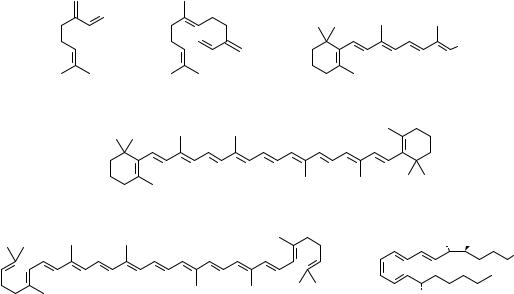
362
CHO
(1) |
(2) |
(3) |
(4)
HO OH
COOH
OH
(5) |
(6) |
FIGURE 1
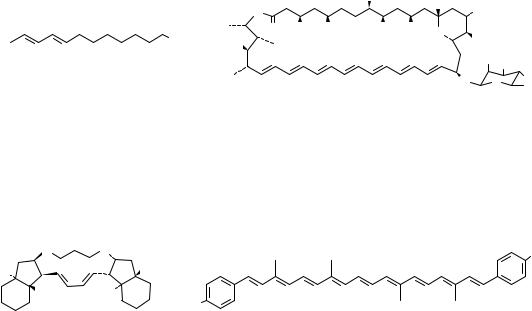
|
|
|
OH |
OH |
|
|
|
|
O |
|
|
OH |
|
|
|
|
|
|
|
|
|
||
|
O |
OH OH |
OH OH |
O |
COOH |
|
|
OH |
|
|
|
|
|||
HO |
|
|
|
|
|||
|
|
|
|
|
|
|
|
|
|
|
|
|
HO |
NH2 |
|
|
|
|
|
|
|
|
|
|
|
|
|
O |
|
O |
OH |
(7) |
|
|
(8) |
|
|
|
|
H2 N COOH
COOH
OH OH |
OH |
OH OH OH OH |
OH OH OH O OH |
OH OH |
|
|
|
(9) |
|
|
H |
H |
|
|
|
N |
N |
|
NO2 |
|
|
|
|
|
H |
|
H |
|
|
|
H |
H |
|
|
|
|
Me2 N |
|
|
|
(10) |
|
|
(11) |
FIGURE 1. (continued)
363

364 |
Goverdhan Mehta and H. Surya Prakash Rao |
The historical background to diene and polyene synthesis and literature up to 1964 has been reviewed in the earlier volume on alkenes of this series1. Literature up to the 70s has been reviewed exhaustively elsewhere3 and some recent developments have been covered in Comprehensive Organic Chemistry6, Comprehensive Organic Synthesis8 and other monographs4,5. The present chapter provides a comprehensive overview with literature coverage up to mid-1995 and with emphasis on synthetic methods of preparative utility and general applicability. For the sake of convenience, various reactions leading to dienes and polyenes have been pooled together and presented under well known reaction types. Selected examples of commonly used methods, particularly of recent vintage, are gathered in the form of tables to illustrate the utility of the procedure involved. For the sake of convenience, the protecting groups have been abbreviated as ‘P’.
II. ELIMINATION REACTIONS
A. General Aspects
One of the simplest and classical methods for the generation of a diene moiety is through single or double elimination of appropriately functionalized alkane, alkene, allene or alkyne substrate20. The elimination reactions have been employed for the generation of both cyclic and acyclic dienes and polyenes. The eliminations could be either 1,2- or 1,4-. In some cases the elimination may involve rearrangements. A large number of leaving groups and reagents to facilitate the elimination process have been developed. In many of the classical elimination reactions, particularly those leading to the formation of acyclic dienes and polyenes, the reaction conditions employed are usually harsh, leading to low yields. However, more recent methods, such as palladium mediated allylic deacetylation reactions, work under milder conditions to result in products of high stereochemical purity21. In the following, different elimination reactions leading to the formation of dienes and polyenes with an emphasis on more recent developments is presented.
B. Dehydrohalogenations
Bromination of an olefin and double dehydrobromination of the resulting 1,2-dibromide is a classical method for the generation of 1,3-dienes (Table 1). Bromination of a double bond can be done with molecular bromine22 or, more conveniently, with pyridinium bromide perbromide23a. A variety of bases has been employed for dehydrobromination. While potassium hydroxide and sodium methoxide have been used for a long time, lithium carbonate lithium chloride in DMF or hexamethylphosphoric triamide (HMPA) works well in many cases23a. Double dehydrobromination with hindered bases such as potassium t-butoxide or diazabicyclononene (DBN) and diazabicycloundecene (DBU)23e give good results.
Monodehydrohalogenation of allylic halides is another classical method for diene synthesis24. This method is complementary to double dehydrohalogenation as both the 1,2- dihalides and allylic halides are readily accessed from alkenes. The commonly employed protocol for diene synthesis, particularly for cyclic 1,3-dienes, is through the allylic monobromination of the alkene with N-bromosuccinimide or related reagents followed by dehydrobromination with hindered bases such as DBN or DBU (equation 1)25.
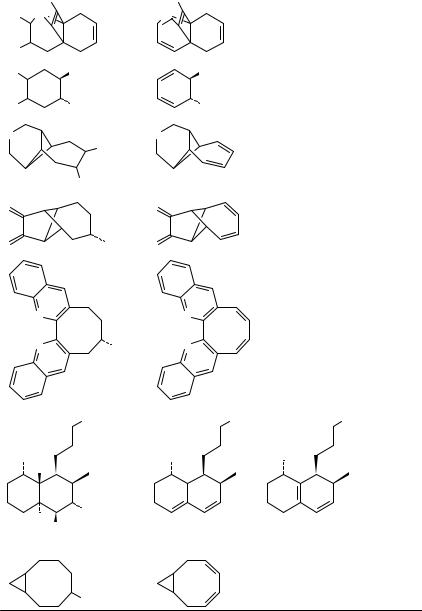
|
|
9. Synthesis of conjugated dienes and polyenes |
365 |
||
TABLE 1. Dienes through double dehydrobromination |
|
|
|||
|
|
|
|
|
|
Substrate |
|
Product |
Reference |
||
|
|
|
|
|
|
|
H3 C |
H3 C |
|
|
|
Br |
H3 C |
H |
C |
|
|
|
3 |
|
|
|
|
|
|
|
|
23a |
|
Br |
|
|
|
|
|
Br |
|
OCOC6 H5 |
OCOC6 H5 |
|
|
|
|
|
|
23b |
|
Br OCOC6 H5
S
Br
Br
 Br
Br
Br
N  Br
Br
N |
Br |
OP
HO
H
Br
H
Br
P= t-BuMe2 Si
• Br
Br
OCOC6 H5
S
23c
23d
N
23e
N
OP |
OP |
HO |
HO |
+ |
23f |
•
• |
23g |
|
Br
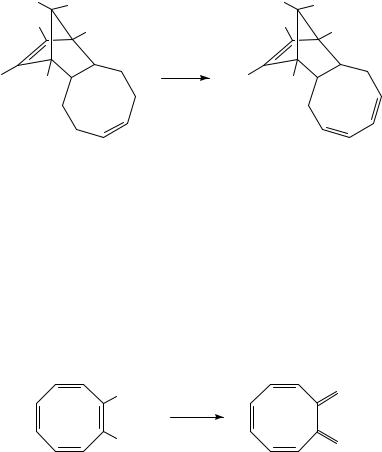
366 |
|
Goverdhan Mehta and H. Surya Prakash Rao |
|
|
|
H3 CO |
OCH3 |
H3 CO |
OCH3 |
|
|
|
||
|
Cl |
Cl |
Cl |
Cl |
|
|
|
||
Cl |
Cl |
1. NBS |
|
2. DBU |
|||
|
|||
|
|
(1)
Cl Cl
C. Dehalogenations
Dehalogenation of 1,2- and 1,4-allylic dihalides offers another simple entry into dienes and polyenes26 (Table 2). Dehalogenations, particularly debrominations, can be achieved by Zn/DMF (equation 2)27, zinc amalgam28a or a combination of activated zinc/potassium iodide and iodine28c. The 1,4-dehalogenation method is particularly useful for the generation of orthoquinodimethanes from the corresponding 1,2-
bisbromomethylbenzene derivatives28c. A high-yielding |
method |
for 1,4-elimination |
of 1,4-dibromo-2-enes to generate 1,3-dienes using a |
catalytic |
amount of sodium |
2-thienyltellurolate has been reported28d. This method can also be used for 1,2- debromination to alkenes. Thus, a 1,2,3,4-tetrabromo compound has been converted to a diene in excellent yields under mild conditions (Table 2)28d. The cis- and trans- perfluoro-1,3,5-hexatrienes which show contrasting properties from those of the parent cis- and trans-1,3,5-hexatrienes have been synthesized by dehalogenation (Cl, Br) using zinc dust28e.
CH2 Br
Zn/DMF
(2)
CH2 Br
D. Dehydration and Related Reactions
Dehydration of allylic alcohols, which are generated either by 1,2-reduction of ˛,ˇ- unsaturated cabonyl compounds or by the nucleophilic addition of a vinyl group to a carbonyl compound, is a routinely employed method for the generation of 1,3-dienes and polyenes. Addition of vinyland polyenyl anions to a carbonyl group and subsequent dehydration will be discussed under a separate section. Allylic dehydrations can be performed by a variety of acidic reagents such as sulphuric acid, phosphoric acid, p-toluenesulphonic acid or Lewis acids such as BF3 Ð Et2O, SnCl4, metal oxides, metal salts as well as solid supports. Examples of diene synthesis through dehydration of allylic alcohols are well documented in the literature. However, three illustrative examples from recent literature employing alumina (equation 3)29a,b, 2,4-dinitrobenzene sulphenyl chloride (equation 4)29c and methyltriphenoxyphosphonium iodide in HMPT (equation 5)29d as dehydrating agents are given here.
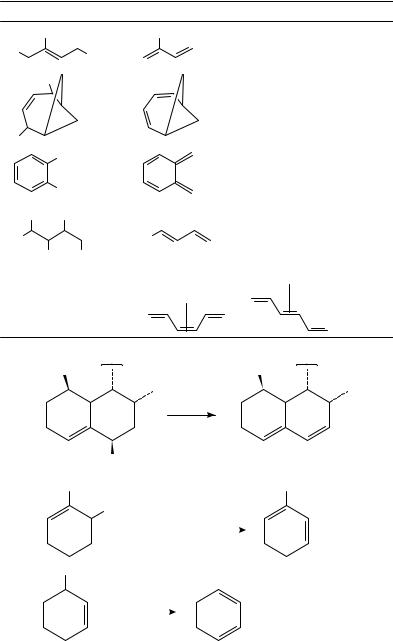
|
9. Synthesis of conjugated dienes and polyenes |
367 |
|
TABLE 2. Dienes through debromination |
|
||
Substrate |
|
Product |
Reference |
CH2 Br |
CH2 Br |
|
|
Br |
Br |
|
28a |
|
|
|
|
Br |
|
|
|
|
|
|
28b |
Br |
|
|
|
|
CH2 Br |
|
|
|
|
|
28c |
|
CH2 Br |
|
|
Br |
Br |
|
|
Ph |
|
Ph |
28d |
|
|
||
Br |
Br |
|
|
|
|
F8 |
|
|
|
F8 |
|
BrCF2 CFClCF2 CFClCF2 Br |
+ |
28e |
|
PO |
PO |
|
|
Al2O3 , ∆
(3)
|
OH |
P = t-BuMe2 Si |
|
|
|
|
|
Ph |
|
|
Ph |
|
OH |
(4) |
|
|
|
2, 4-(O2 N)2 C6 H3 SCl, Et3 N |
|
|
|
|
|
|
|
|
|
OH
(PhO)3 P +CH3 I− |
(5) |
HMPT, 50˚C |
|

368 |
Goverdhan Mehta and H. Surya Prakash Rao |
Allylic alcohols can be converted to dienes by a two-step method involving activation of the hydroxy group to a better leaving group and elimination30. These eliminations are commonly conducted in the presence of non-nucleophilic bases employing mesylate (OMs) or tosylate (OTs) derivatives (Table 3)31. Cyclic ene-1,4-diol mesylates can also be converted to dienes on treatment with sodium iodide in acetone32. Allylic acetates can also serve as precursors of dienes through elimination of acetic acid33 as applied in the synthesis of the natural product trichonine (equation 6)33a. An interesting application is the transformation of neryl acetate to myrcene in quantitative yield in the presence of propargylzinc bromide and Pd(PPh3)4 catalyst (equation 7)34. Palladium catalysed 1,4- elimination in allylic carbonates also leads to dienes (equation 8)35.
OH
CH3 (CH2 )15 COOMe
COOMe
3. Me2 A l N
1. A c2 O, DMA P, Py |
|
2. Mo(CO)6 |
OTMS |
|
|
H3 C |
|
|
NTMS |
(6)
O
|
CH3 (CH2 )14 |
N |
|
|
Trichonine |
|
HC CCH2 ZnBr |
|
|
Pd(PPh3 )4 |
|
|
OAc |
(7) |
|
|
|
|
O |
OH |
PO |
Pd2 (dba)3 , PPh3 |
PO |
|
|
(8) |
O O
P= p-MeOC6H4 CH2
E. Reductive Deoxygenations
Reductive deoxygenation-rearrangement of 2-yne-1,4-diols to 1,3-dienes is a useful synthetic procedure since a large variety of ynediols are available in a few steps by sequential reaction at both ends of acetylene with aldehydes. Acetylenic 1,4-diols can be deoxygenated reductively by lithium aluminium hydride to form conjugated dienes of high stereoisomeric purity (equation 9)36. A modification to this procedure is the use of acetylenic 1,4-diol mono-THP derivative37. Allenic tertiary alcohols which are intermediates in the reaction can be separated and subjected to reductive elimination rearrangement
